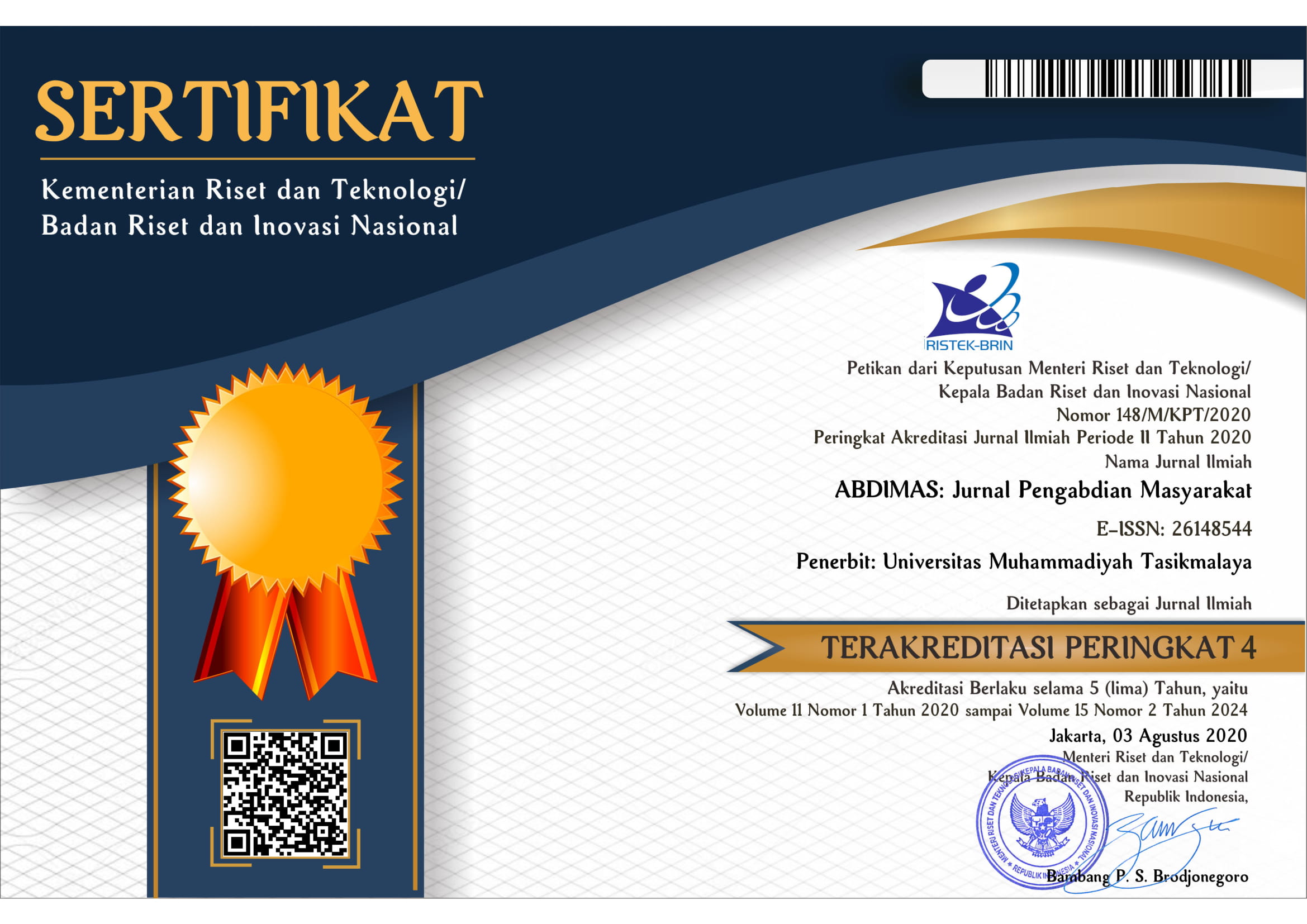Assistance in the Development of RBL-STEM Learning Tools Based on AI and IoT to Improve Students' Thinking Skills
DOI:
https://doi.org/10.35568/abdimas.v7i1.4156Keywords:
RBL-STEM, Mathematics Learning, Community ServiceAbstract
A teacher is an educator who is required to continuously develop his skills and knowledge. Learning today is no longer learning that can be packaged conventionally if the teacher wants good learning outcomes. Current learning must be able to increase students' interest in learning. One type of learning that is currently trending is learning based on artificial intelligence and Internet of things (IoT). The quality of human resources can be seen from the ability of graduates who have skills, master technology, and have extensive knowledge and professional expertise. To improve the digital literacy competency of educators, the Unej service team carries out community service. The training activities carried out aim to increase teacher competency in utilizing AI and IoT as learning media especially in developingRBL-STEM learning tool. The implementation of this training uses the IHT method, lectures and mentoring. As a result, participants were able to create digital learning assisted by AI and IoT. Based on the results of media trials on students based on pretest and posttest, a probability or Sig value was obtained. (2-tailed) is equal to 0.000 with an alpha of 0.05, meaning there is a significant difference between the results on the pretest and posttest. In the posttest results, it was found that students' scores had increased in their thinking abilities.
Downloads
References
Adawiyah, R., & Kristiana, A. I. (2023). Improving Educators Digital Literacy Through Assistance in the Development of Lectora Inspire-Based Mathematics Learning Media. ABDIMAS: Jurnal Pengabdian Masyarakat, 6(4), 4343–4351.
Djuhartono, T., Wibowo, P. A., & Haryanto, H. (2023). Class Action Research Workshop With Participant Active Learning for Educators in Gugus 04 Primary School Level Ciputat District–South Tangerang City. ABDIMAS: Jurnal Pengabdian Masyarakat, 6(4), 4387–4400.
Fatahillah, A., Wati, Y. F., & Susanto. (2017). Analisis Kesalahan Siswa dalam Menyelesaikan Soal Cerita Matematika Berdasarkan Tahapan Newman Beserta Bentuk Scaffolding yang Diberikan. Kadikma: Jurnal Matematika Dan Pendidikan Matematika, 8(1), 40–51. https://doi.org/https://doi.org/10.19184/kdma.v8i1.5229
Hobri. (2010). Metodologi Penelitian Pengembangan [Aplikasi pada Penilitian Pendidikan Matematika]. Pena Salsabila.
Ja’far, M., Sunardi, S., & Kristiana, A. I. (2014). Pengembangan Perangkat Pembelajaran Berbasis Karakter Konsisten Dan Teliti Menggunakan Pendekatan Realistic Mathematics Education ( RME ) Pada Bab Kesebangunan Dan Kekongruenan Bangun Datar Kelas IX SMP ( The Development of Mathematics Learning Aids Based. Jurnal Edukasi UNEJ, I(3), 29–35.
Kristiana, A. I., Ridlo, Z. R., Prihandini, R. M., & Adawiyah, R. (2022). The Research Based Learning--STEM Learning Activities: The Use of r-Dynamic Coloring to Improve the Students Metaliteracy in Solving a Tessellation Decoration Problem. ArXiv Preprint ArXiv:2203.11673.
Lutvaidah, U. (2016). Pengaruh Metode dan Pendekatan Pembelajaran terhadap Penguasaan Konsep Matematika. Formatif: Jurnal Ilmiah Pendidikan MIPA, 5(3), 279–285. https://doi.org/http://dx.doi.org/10.30998/formatif.v5i3.653
Najib, M. I. L., Manan, N. A., & Hadiana, O. (2023). Soft Skill and Hard Skill Training for Students at Eakkapapsasanawich Islamic School Krabi Thailand. ABDIMAS: Jurnal Pengabdian Masyarakat, 6(4), 4297–4302.
Prasetyaningrum, P., & Lewoema, S. L. Z. (2023). Digital Transformation for the Future of Education: Community Service in Website Design Company Profile Tutoring Institution Scholastica Education Center (SEC). ABDIMAS: Jurnal Pengabdian Masyarakat, 6(4), 4367–4376.
Purwati, R., Hobri, & Fatahillah, A. (2016). Solving, Analisis Kemampuan Berpikir Kritis Siswa dalam Menyelesaikan Masalah Persamaan Kuadrat pada Pembelajaran Model Creative Problem Solving. Kadikma: Jurnal Matematika Dan Pendidikan Matematika, 7(1), 84–93.
Runisah, Ismunandar, D., Gunadi, F., & Nurafifah, L. (2019). Pelatihan Penggunaan Geogebra Sebagai Upaya Untuk Meningkatkan Profesionalisme Guru SMP/MTS Di Kecamatan Sindang Indramayu. Abdi Wiralodra : Jurnal Pengabdian Kepada Masyarakat, 1(2), 67–79. https://doi.org/10.31943/abdi.v1i2.12
Safiati, O. A., Wiyanti, D., Dafik, Ridlo, Z. R., & Adawiyah, R. (2022). Kerangka Aktivitas Research Based Learning dengan Pendekatan STEM: Pemanfaatan Cardboard Bekas dalam Mendesain Dispenser Sederhana Berdasarkan Konsep Hukum Pascal dan Bernoulli serta Tekanan Hidrostatis untuk Meningkatkan Metaliterasi Siswa. Ebook CGANT Universitas Jember.
Subekti, A. S., Winardi, A., & Susyetina, A Lestariningsih, F. E. (2021). Online English Club for High School Students: Going Globa. ABDIMAS: Jurnal Pengabdian Masyarakat, 4(2), 770–781.
Suzana, R., Supandi, & Rahmawati, N. D. (2019). Pengaruh Model Pembelajaran Creative Problem Solving Berbantu Mind Mapping Pada Pembelajaran Matematika. Senatik 4: Seminar Nasional Matematika Dan Pendidikan Matematika, 356–361. http://conference.upgris.ac.id/index.php/senatik/article/view/78/61
Trapsilasiwi, D., Oktavianingtyas, E., Putri, I. W. S. Adawiyah, R., & Albirri, E. R. Firmansyah, F. F. Andriani, Y. (2019). Mathematical Literacy of Male and Female Students in Solving PISA Problem by “Shape and Space” Content. In Journal of Physics: Conference Series (Vol. 1218, No. 1, p. 012019).














